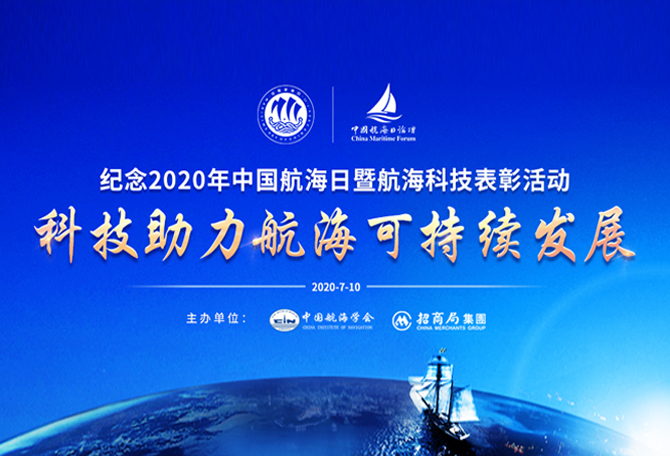These data-driven automated wharf process systems such as Intelligent production management system and simulation platform based on cyber-physical system, automatic wind-proof anchoring for large equipment, AGV cycle charging mode...etc. have given rise to many unmanned wharfs in China, with dockworkers turning into computer operators. Then where will the captain be when the ship is under sail in the future?
"Most of the time, the captain will be at the navigation control center ashore " told Zhang Baochen, the executive vice chairman of the Institute, to the reporter of Science and Technology Daily, on July 10, at the online "Commemoration of 2020 China Maritime Day and Maritime Science And Technology Commendation Activity" hosted by the China Institute of Navigation and China Merchants Group. In recent years, scientists have made major theoretical innovations in intelligent shipping and proposed the concept of "Intelligent Shipping" and the model of "Navigation Brain”

What is "Intelligent Shipping" and "Navigation Brain"?
"Intelligent shipping is a new shipping system and new business model formed by the deep integration of modern information, communications, perception, big data, artificial intelligence and other high-tech and traditional shipping elements. It is an inevitable trend for the future development of the shipping industry." said Zhang Baochen. Intelligent shipping system includes five key elements: intelligent ships, intelligent ports, intelligent shipping insurance, intelligent shipping services, and intelligent shipping supervision.
Yan Xinping, an academician of the Chinese Academy of Engineering, who is leading a team to conduct research on "Navigation Brain", explains the concept "Navigation Brain". In Yan Xinping's view, the "Navigation Brain" system obtains information about the ship's environment and its own state through the "Perceived Space". The "Cognitive Space" abstracts the navigational situation and knows its own state based on the perceived information, and establishes an intelligent ships steering behavior spectrum based on manual steering records and machine learning training; the "Decision Execution Space" uses the feedback information of the "Perceived Space" to modify the situational cognition in the "Cognitive Space", and realizes robust control of intelligence ships with the support of the steering behavior spectrum .
China's first "Report on the Development of China's Navigation Technology" to be published this year, shows that China's intelligent navigation technology has made many initial achievements in intelligent navigation technology. It has developed cloud platforms, six degrees of freedom and intelligent navigation simulators; It has designed an intelligent ship "1+N" technical system framework, and proposed an overall intelligent ship solution; it has built an intelligent ship experimental test field; independently developed an ultra-short baseline positioning system, and successfully conducted a 10,000-meter-level sea trial in the deepest "Challenger's Depth" area of the Mariana Trench, and for the first time it has provided precise coordinates on the seabed with a water depth of more than 10,000 meters.
"China has independently developed and put into use the 20-meter-level intelligent navigation experimental test ship named "Zhiteng", which has multiple steering modes such as manual steering autonomous navigation and remote-control steering." said Zhang Baochen. At present, "Zhiteng" is conducting a number of scientific research data collection at the intelligent ship experimental test field.
The ship is testing artificial navigation, remote control and autonomous navigation, as well as underwater collision avoidance and automatic docking at the Intelligent shipping technology Innovation and integrated experimental base in Blue Valley, Qingdao.
The marine ship intelligent navigation test field is the supporting part of the National Key Research and Development Project "The Key Technology of Ship Intelligent Navigation and Control Based on Ship-Shore Collaboration". It is located in the sea area near Qingdao Jimo Aoshan Bay, covering an area of 220 square sea miles. The test field is equipped with relevant functional experiment test field for entering and leaving ports, berthing and unberthing, anchoring, and collision avoidance in restricted waters, and the vectorization of the sea charts in the relevant areas has been completed. An operation and control center of independent research and development has been built, including supporting ship remote control shore-end systems, large-screen display systems, CCTV monitoring, and microwave communication systems.
"Compared with the world's leading countries in navigation technology, China still has a long way to go in ship driving instruments, ship electromechanical equipment, and ship communication and navigation." said Zhang Baochen.
In order to promote China's development into a maritime power, China's Marine science and technology has been increasing investment in scientific research, with the establishment of five national key laboratories and engineering research centers, and 22 industrial key laboratories and R&D centers. The Ministry of Transport and other relevant ministries and commissions have successively formulated a series of policy documents, such as "Action Outline for Promoting the Development of Comprehensive Transportation Big Data (2020-2025)", "Outline of the Plan for Medium and long-term Scientific and Technological Innovation in Transportation (2021-2035)", "The Outline of the Digital Transportation Development Plan", which provide a good policy environment for the development of navigation technology and the implementation of the concept of intelligence, safety, greenness and sharing.
The theme of the "2020 China Maritime Day and Marine Science and Technology Commendation" held on July 10 was "Science and Technology contributing to sustainable development of navigation". Many guests from government departments, shipping companies, scientific research institutions and other institutions shared new ideas and practices in the field of navigation science and technology. Several awards were announced, such as the Science and Technology Award of China Navigation Society in 2019, the 4th Youth Science and Technology Award of China Navigation Association, Outstanding Contribution Award of Science and Technology of China Navigation Society in 2019(Team), and Outstanding Contribution to Science and Technology Award of China Navigation Society in 2020 (Individual).
